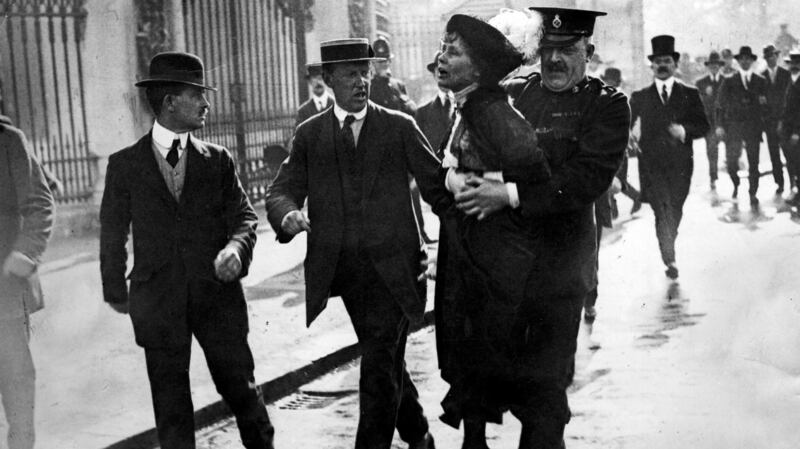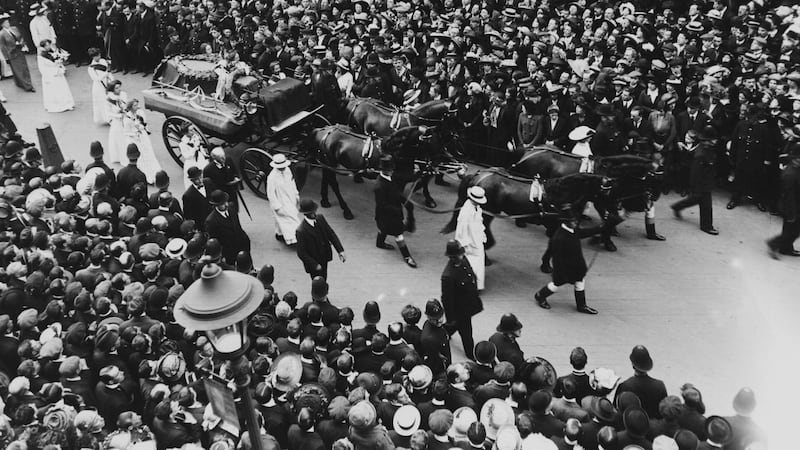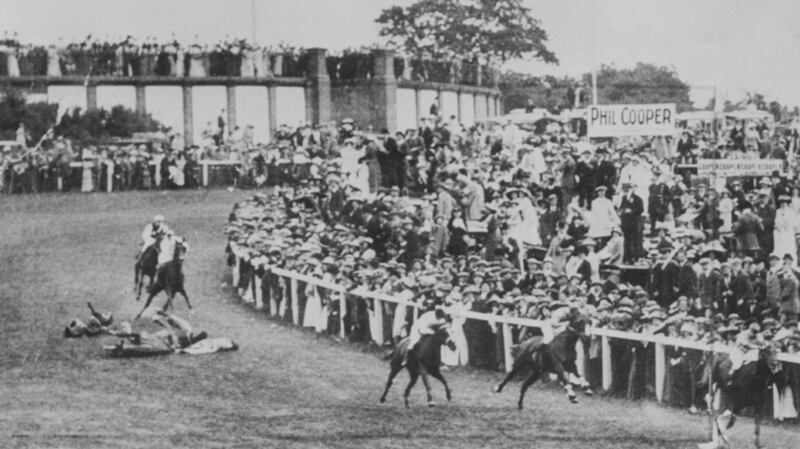Tuesday marked the centenary of the Representation of the People Act which gave some women the vote, and extended it to all men over 21 years of age. This is the first time that we in Ireland have had such a hooley for its anniversary. Where the 50th anniversary was marked in Britain in 1968, it went largely unnoticed and unmarked in Ireland.
Perhaps it was still too soon to celebrate legislation passed in the imperial parliament of Westminster, but the relative lack of women’s voices in public life at the time was more pertinent. In 1968, in an Oireachtas of 204 members, only nine were women - five TDs, of whom four were elected as widows of deputies, and four Senators, two of whom were related to men executed in 1916.
In 1968 women were outnumbered everywhere in Irish public life. Women’s history was yet to blossom in either teaching or publishing. The women’s liberation movement of the 1970s was not quite organised, but women’s voices were becoming louder through a new wave of journalism. Conventional party politics in Ireland had long maintained or increased discrimination against women in areas such as property rights, the right to work, and control over their bodies. By necessity, women had to organise outside the political system to vindicate their rights. The vote was not enough when the system and the culture was unwilling to yield.

Fifty years on from 1968, the situation has changed beyond recognition, but every bit of progress was resisted and hard fought before it was won. Legal equality is the norm in Ireland now but informal discrimination, harassment and violence are far too common. Women are increasingly prepared to call it out when they see it. Some men react angrily to this, while many others laugh it off as whining or over-reaction. All too often matters which relate entirely or primarily to women - including things like pension rights or their very bodies - are ignored or treated as though they are “not real politics”.
The centenary of the franchise is an opportunity, then, to look back not only at the campaign for the vote but also the degree to which political equality, in its crudest form, has benefitted women. The four volumes here do that, with two histories looking back at the struggle, and the other two reflecting on women’s status and how to improve it.
Women and the vote
Irish Women and the Vote (Irish Academic Press, 258 pp, €19.99) is a collection of essays which has been republished as a new edition to coincide with the centenary of the Representation of the People Act. Its editors have written extensively in the area and Margaret Ward's Hanna Sheehy Skeffington, Suffragette and Sinn Féiner: Her Memoirs and Political Writings was published last year to great acclaim.
Along with two forewords and an introduction, it features 13 chapters on women and the vote in Ireland by historians and scholars in other disciplines from Ireland and abroad. The collection takes a broad sweep through the subject, beginning with the sisters of the United Irishmen in the 18th century and going up to the eve of the declaration of the Republic in 1949.
The first two chapters by Mary Cullen and Carmel Quinlan cover early examples of Irish feminism and the campaigns that saw women become eligible to serve as poor law guardians and those with particular property qualifications eligible to vote in local elections. It was a mostly Protestant, often Quaker, middle class movement, with deep roots in social reform, but it grew broader in the early 20th century and this provides the book’s main focus.
There are elements of the WSPU's campaigning which are much in evidence in modern feminist campaigns, especially in Ireland
Each essay in this collection shines a light on a particular aspects of the fight for the vote in Ireland, and brings to life different themes and problems. There are chapters which take local or regional looks at the movement. Mary Clancy’s chapter about Galway includes Christabel Pankhurst’s visit to the city on the invitation of the Irish Women’s Franchise League (IWFL), where Pankhurst’s efforts to discuss rural inequality and emigration turned out to be ill-suited for her middle class audience.
Notably, this was far from the only time English feminists showed insensitivity or even disregard towards their Irish sisters. A similar failure to connect was apparent when middle class women’s suffrage campaigners from Dublin were brought to Belfast to talk to mill girls there, which Denise Kleinrichert records in her examination of the suffrage issue and the mill-workers in Belfast.
The great Winifred Carney, best known as James Connolly’s right hand woman, features prominently here. She was just one of many figures within the women’s suffrage movement who were active in socialist politics and trade unions at that time. These included Hannah Sheehy Skeffington, Louie Bennet, Helena Moloney and Countess Markievicz, to name only a few.

No one was expected to choose between the fight for women’s rights and or for socialism; then, as now, the struggles intersected. Many were also strongly involved in the separatist movement and would go on to oppose the Treaty in 1922. Many of the women who fought for the right to vote also asserted their right not to sit in a parliament or, more accurately, parliaments whose legitimacy in Ireland they did not recognise.
Women’s bodies and the law
Two chapters that will resonate strongly with modern readers relate to women’s bodies and the law. The treatment of women in the criminal justice system and frequently lenient treatment of men in cases of violence against them, is a perennial grievance. As Louise Ryan notes in her chapter, the campaign for votes for women was only part of the picture of the movement at that time. In a fascinating chapter, Ryan looks at the Watching the Court committee which monitored and reported on sexual assault cases in the Dublin court and was led by Marion Duggan. Duggan was a qualified lawyer but could not practise, since the Sex Disqualification Act, which first allowed women to practice law, was not passed until 1919.
Imprisonment and, from 1909, hunger strikes, were crucial elements of the militant suffrage campaign. Will Murphy’s chapter gives an absorbing account of the women’s suffrage movement and political imprisonment in Ireland. It considers matters such as the status of prisoners, the conditions in which Irish campaigners were imprisoned (better than in England) and the fraught relations between the Irish suffragists and their English sisters in the Women’s Social and Political Union (WSPU) sisters.
When a group of the latter joined them in Mountjoy, having travelled to Dublin, unasked, and attacked the prime minister, H H Asquith who was on an official visit, the Irish activists were not best pleased. Looking at the legacy of the women’s imprisonment, Murphy observes how hunger strikes, now more closely identified with the republican movement, was a tactic pioneered by militant women and subsequently copied by others, most notably in the revolutionary period. Some men saw no shame in acknowledging the women’s influence but others were afraid to be seen to copy the suffragettes. When republican prisoners went on hunger strike during the Civil War, Kevin O’Higgins accused them of using a “women’s weapon”.

This “weapon” required a level of endurance and nerve far beyond hunger or weakness from starving, with much greater distress and damage caused by the force feeding which was regularly inflicted on hunger strikers in England. An act of great violence, it was a dangerous procedure (it cost Thomas Ashe his life in 1917) which could cause grave physical and emotional damage to those who underwent it, often many times over.
Theresa May is described as a feminist - and she has been photographed wearing a t-shirt with 'This is What a Feminist Looks Like' printed on it - but there is no real attempt to interrogate her policies
Sadly, there are too many gruelling accounts of the act in Rise up, Women! The Remarkable lives of the Suffragettes (Bloomsbury, 670pp, £30), a mammoth history of the WSPU, the militant suffragette organisation established by Emmeline and Christabel Pankhurst, among others, in Manchester in 1903.
‘Deeds Not Words’
Diane Atkinson, author of several studies of the suffragette movement, tells the story of the WSPU’s 11-year campaign to secure votes for women, which departed from the more ladylike efforts of its predecessors such as Millicent Fawscett’s National Union of Women’s Suffrage Societies. Following the dictum of “Deeds not words” the WSPU began by disrupting public meetings before moving on to public order offences such as window breaking and civil disobedience, such as the 1911 census boycott, and eventually moving on to arson attacks on property. Controversially, the campaign was brought to a halt by the Pankhursts on the outbreak of the first World War in 1914. Ireland seldom features, although we are introduced to activists including Charlotte Despard (“Madame Desperate” as my granny called her), who was briefly a member of the WSPU and was a founder member of the IWFL and, of course, Eva Gore-Booth, suffrage campaigner and sister of Constance Markievicz.
At 670 pages, the book is somewhat unwieldy, but it a tour de force which paints an intricate and vivid picture of the organisation and the fascinating women who devoted their lives to it and charts their many challenges and false dawns before the campaign was suspended in 1914. It is handsomely produced and features scores of wonderful photographs. Its cover is based on Sylvia Pankhurst’s illustration for the WSPU membership card, featuring a young working class woman marching among others, in the union’s trademark green white and purple.
There are elements of the WSPU’s campaigning which are much in evidence in modern feminist campaigns, especially in Ireland. They share an emphasis on aesthetics and theatricality, whether it is WSPU processions being led by Joan of Arc on horseback, or the red-clad women “bishops” or handmaidens who can be seen in contemporary demonstrations. There are the colour schemes and outfits, whether they be the tricolour sashes, black REPEAL sweatshirts or pink “pussy” hats. There are echoes of the way in which they are discussed by critics whose use of words such as “shrill” or “hysterical” to describe women, along with their policing of tone, is indistinguishable from 100 years ago.

Women’s rights today
While the two history books here focus on the campaign for the vote, the final two books try to evaluate where it got us and how we could do better. Helen Pankhurst works in an international development agency and was awarded a PhD for her study on gender and identity in Ethiopia. This, and her family background - she is a granddaughter of Sylvia and great-granddaughter of Emmeline, inform Deeds not Words. The Story of Women's Rights Then and Now (Sceptre, 376 pp, £25).
Featuring some historical background, the book is a series of thematic chapters on different aspects of women’s life - politics, money, identity, violence, culture and power - which provides a summary of how women have fared in each area in England in the century since women got the vote, before awarding marks out of five for progress.
Just as getting the vote was about more than voting, the centenary is about far more than parliament
Assessing progress in every part of life over a century is an ambitious task for a single volume. The chapter on politics, for instance, whips through 100 years of local, regional and national politics, the judiciary, media and civil society in 44 pages.
Perhaps inevitably, it leads to a rather shallow reading of events. At one point Pankhurst singles Labour out as a party which is hostile to women perhaps because of its “historic close ties to trade unions and a male-dominated group-think which has alienated many women”. However she fails to interrogate the performance of either the Conservatives or Liberal Democrats. Theresa May is described as a feminist - and she has been photographed wearing a t-shirt with “This is What a Feminist Looks Like” printed on it - but there is no real attempt to interrogate her policies whether as home secretary or as prime minister and judge her on her deeds, not words.
A local stage
The book is also very English. Everything that is examined is English, but how, in an online age, can anyone make any serious judgement on culture or politics on so local a stage? A section on women in pop music seems more like a playlist from the late Terry Wogan's show on BBC Radio 2 and include Annie Lennox OBE, who incidentally, provides one of a litany of endorsements from women with whom BBC Radio 4 listeners will be familiar. It will find plaudits on Women's Hour, no doubt, and maybe it might radicalise fans of Annie Lennox, but it is doubtful it will speak much to Irish readers and will certainly not appeal to many fourth wave feminists.
Equal Power and How You Can Make it Happen (Atlantic Books, 382pp, £16.99) is written by Liberal Democrat MP and deputy leader Jo Swinson who asserts that "this isn't just a book, it's a call to arms".
In common with Helen Pankhurt, Swinson takes a number of similar thematic chapters, in this case politics, childhood, bodies, parenting, work, culture, sport, violence, men, in which she discusses women’s experience or strength in each and then gives several pages of bullet points of actions that women might take up, such as having your book club choose something about a less well-known woman from history.
A century on from 1918, there are now considerably more women in Irish representational politics than there was even 10 years ago
Accessible, if rather lightweight, Equal Power is strongest where it is most personal such as when Swinson talks about her own experience of becoming involved in party politics, which was followed by her election to Westminster as a 25-year-old in 2005 and later her time spent as a junior minister in the coalition with special responsibility for women. She recalls the debate in the Liberal Democrats over women-only shortlists, which Labour had used with great success, but which she opposed successfully.
By the time of Swinson’s election in 2005, Westminster was still a boys’ club, with one in five MPs women. But it had lost the very worst excesses of its boorish public school character which had seen MPs make “melon gestures” with their hands on their chests whenever women MPs rose to speak in the House, which had been the case after the 1997 election.
That was the election when, after the Labour landslide and as a consequence of women-only shortlists, the number of women MPs doubled to 120, the new intake labelled in the press as “Blair’s babes”. There is also the very current matter of sexual harassment and assault in Westminster, with Swinson recalling having made complaints about her party’s chief executive, Lord Rennard. Rennard, as she notes, remains in the party and many of the women involved have left.
Sheryl Sandberg's Lean In is mentioned or discussed several times and Equal Power is trying to do the same for politics. Equal Power is an easy read, whether someone will find it useful will rather depend on their attitude towards Sandberg's glossy, corporate feminism.
Women in Irish politics
A century on from 1918, there are now considerably more women in Irish representational politics than there was even 10 years ago. In the Republic, there have been three women tánaistes and three parties in the Dáil have been led by women; next week there will be a fourth. The two largest parties in the North are also led by women. The Dáil now has its highest proportion of women ever and that happened largely because of campaigns that pressed for it. How much this is influencing politics is hard to tell, not least because there is no such thing as “women’s politics”, but in matters such as the referendum on repealing the Eighth Amendment, it seems unlikely that it has not played some part. But just as getting the vote was about more than voting, the centenary is about far more than parliament. If nothing else, it reminds us that progress is not inevitable and that rights are seldom granted freely; they are fought for and conceded and once won, must be fought to be maintained.
Niamh Puirséil is a historian. Her latest book is Kindling the Flame: 150 Years of the Irish National Teachers Organisation
Irish Women and the Vote: Becoming Citizens by Louise Ryan and Margaret Ward (eds) Irish Academic Press, 258 pp, €19.99
Rise Up, Women! The Remarkable Lives of the Suffragettes by Diane Atkinson, Bloomsbury, 670pp, £30
Equal Power and how you can make it happen by Jo Swinson, Atlantic Books, 382pp, £16.99
Deeds not Words: The Story of Women's Rights, Then and Now by Helen Pankhurst, Sceptre, 376 pp, £25











